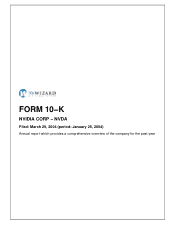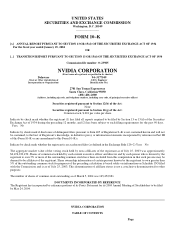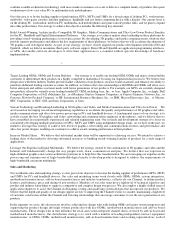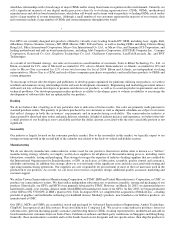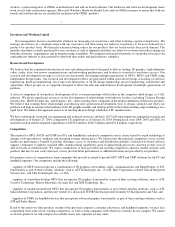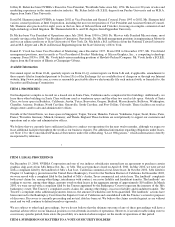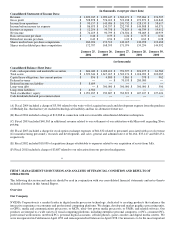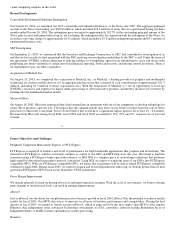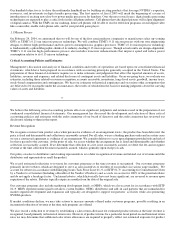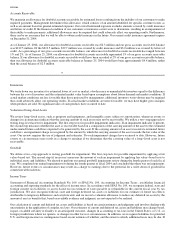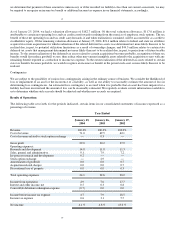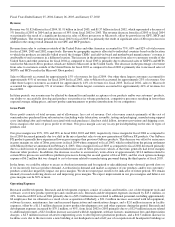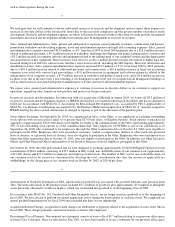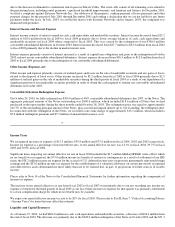NVIDIA 2004 Annual Report Download - page 10
Download and view the complete annual report
Please find page 10 of the 2004 NVIDIA annual report below. You can navigate through the pages in the report by either clicking on the pages listed below, or by using the keyword search tool below to find specific information within the annual report.
6
Patents and Proprietary Rights
We rely primarily on a combination of patents, trademarks, trade secrets, employee and third−party nondisclosure agreements and
licensing arrangements to protect our intellectual property in the United States and internationally. We have numerous patents issued
and pending in the United States and in foreign countries. Our patents and pending patent applications relate to technology used by us
in connection with our products, including our digital media processors. We also rely on international treaties and organizations and
foreign laws to protect our intellectual property. We continuously assess whether and where to seek formal protection for particular
innovations and technologies based on such factors as: the commercial significance of our operations and our competitors’ operations
in particular countries and regions; the location in which our products are manufactured; our strategic technology or product directions
in different countries; and the degree to which intellectual property laws exist and are meaningfully enforced in different jurisdictions.
Our pending patent applications and any future applications may not be approved. In addition, any issued patents may not provide us
with competitive advantages or may be challenged by third parties. The enforcement of patents by others may harm our ability to
conduct our business. Others may independently develop substantially equivalent intellectual property or otherwise gain access to our
trade secrets or intellectual property. Our failure to effectively protect our intellectual property could harm our business. We have
licensed technology from third parties for incorporation in our digital media processors, and expect to continue to enter into license
agreements for future products. These licenses may result in royalty payments to third parties, the cross licensing of technology by us
or payment of other consideration. If these arrangements are not concluded on commercially reasonable terms, our business could
suffer.
Employees
As of January 25, 2004 we had 1,825 employees, 1,057 of whom were engaged in research and development and 768 of whom were
engaged in sales, marketing, operations and administrative positions. None of our employees are covered by collective bargaining
agreements, and we believe our relationships with our employees are good.
Financial Information by Business Segment and Geographic Data
We operate in a single industry segment: the design, development and marketing of GPUs, MCPs, UMPs and related software that are
integral to a wide variety of visual computing platforms including enterprise PCs, consumer PCs, professional workstations, notebook
PCs, personal digital assistants, cellular phones, game consoles and digital media centers. The information included in Note 16 of the
Notes to the Consolidated Financial Statements is hereby incorporated by reference.
Management
The following sets forth certain information regarding our executive officers, their ages and their positions as of January 25, 2004:
Name Age Position
Jen−Hsun Huang 40 President, Chief Executive Officer and
Director
Marvin D. Burkett 61 Chief Financial Officer
Jeffrey D. Fisher 45 Executive Vice President, Worldwide Sales
David M. Shannon 48 Vice President, General Counsel
Di Ma 51 Vice President, Operations
Daniel F.Vivoli 43 Executive Vice President, Marketing
7
Jen−Hsun Huang co−founded NVIDIA in April 1993 and has served as its President, Chief Executive Officer and a member of the
Board of Directors since its inception. From 1985 to 1993, Mr. Huang was employed at LSI Logic Corporation, a computer chip
manufacturer, where he held a variety of positions, most recently as Director of Coreware, the business unit responsible for LSI’s
"system−on−a−chip" strategy. From 1983 to 1985, Mr. Huang was a microprocessor designer for Advanced Micro Devices, a
semiconductor company. Mr. Huang holds a B.S.E.E. degree from Oregon State University and an M.S.E.E. degree from Stanford
University.
Marvin D. Burkett joined NVIDIA as Chief Financial Officer in September 2002. From February 2000 until joining NVIDIA, Mr.
Burkett was a financial consultant and served as CFO of Arcot Systems, a security software company. From 1998 to 1999, Mr.
Burkett was the executive vice president and CFO of Packard Bell NEC. Mr. Burkett also previously spent 26 years at Advanced
Micro Devices, or AMD, where he held a variety of positions including CFO, senior vice president and corporate controller. Mr.
Burkett holds B.S. and M.B.A. degrees from the University of Arizona.

